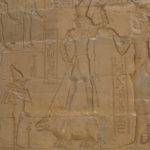By Adrienne Mayor (regular contributor)
Ancient Egyptian worshippers of Set, god of darkness and chaos, collected fossils of extinct beasts by the thousands. From 1300 and 1200 BC, nearly three tons of heavy, black fossils, polished by river sands, were brought to Set shrines on the Nile. Many of the bones were wrapped in linen and placed in rock‑cut tombs.
The immense troves of fossils heaped at Qau el-Kebir and Matmar were discovered in 1922-24 by archaeologists Guy Brunton and Sir Flinders Petrie, stunning evidence that Egyptians revered large stone bones as sacred relics of Set. The god was often associated with the hippopotamus, and many of the fossils belonged to hippos, but remains of extinct crocodiles, boars, horses, giant antelope, and buffalo were also found.
In 1926, geologist K. S. Sandford explored 500 miles around Qau but failed to locate the source of “this strange collection of animals,” which appear to be of the Pliocene‑Pleistocene era. Sandford commented, “We await the verdict of the paleontologist with the greatest interest.” In 1927, Brunton wrote that the tons of fossils would be “the subject of a special memoir”; in 1930 he again promised a volume devoted to the fossils.
But that was the last word about the extraordinary black bones of Set. The fossils were forgotten by the scientific community.
In 1998, I contacted paleontologist Andrew Currant, Curator of Quaternary Mammals, Natural History Museum, London, to inquire whether there were any records of the fossils discovered by Brunton and Petrie. Currant learned that a large “undocumented collection” of fossils from Qau were stored in a warehouse in Wandsworth. They were still in the original crates that Brunton and Petrie had shipped from Egypt. As I pointed out in The First Fossil Hunters (Princeton, 2000), the fossils gathered by ancient Egyptians more than 3,000 years ago–languishing in unopened crates in South London since 1920s–surely deserved scientific study by paleontologists and Egyptologists.
My book also described some Qau fossils wrapped in linen located in 1999 by archaeologist David Reese–who also tried in vain to convince the National Museum to open their crates of fossils. Reese learned that a collection of ancient Egyptian textiles from the Petrie Museum had been de-acquisitioned by the Victoria and Albert Museum and then acquired by the Bolton Museum (Manchester). In response to our queries, Angela Thomas, senior keeper at the Bolton, realized that some very ancient linen items of peculiar bulk had been inadvertently included with the textiles from the V&A. Labels scrawled on the backs of envelopes in Petrie’s handwriting confirmed that these bundles were some of the long‑lost linen‑wrapped fossil bones discovered at Qau in 1923.
Inspired by this intriguing report, Egyptologist Tom Hardwick and geologist David Craven at the Bolton opened an investigation to determine the identity of the bones in 2007. They introduced a “Bone Bundle Mystery” contest, with a prize for guessing what sort of fossil was inside one of the bundles. Unwrapping revealed the scaphoid (foot bone) of a giant, extinct antelope/wildebeest. (Curiously, the Bolton Museum has removed evidence of the contest and identification of the fossils from their website, despite renewed interest in the fossils in 2016.)
Seven years later, in 2014, another bundle at the Bolton was examined by X-ray CT scanning ( http://www.ironfromthesky.org/?p=276&). In 2016, the Egypt Exploration Society awarded a grant ( http://www.ironfromthesky.org/?p=393 ) to Pip Brewer (Natural History Museum, London) and Diane Johnson (Open University) to finally unlock the dusty old crates that Currant, Reese, and I had located 16 years ago.
At long last, it appears that modern scientific analysis will determine the origins, species, and dates of the mysterious black bones of Set gathered by ancient Egyptians.
About the author: Adrienne Mayor is the author of The First Fossil Hunters: Dinosaurs, Mammoths, and Myths in Greek and Roman Times; Fossil Legends of the First Americans; and The Amazons: Lives and Legends of Warrior Women across the Ancient World.
